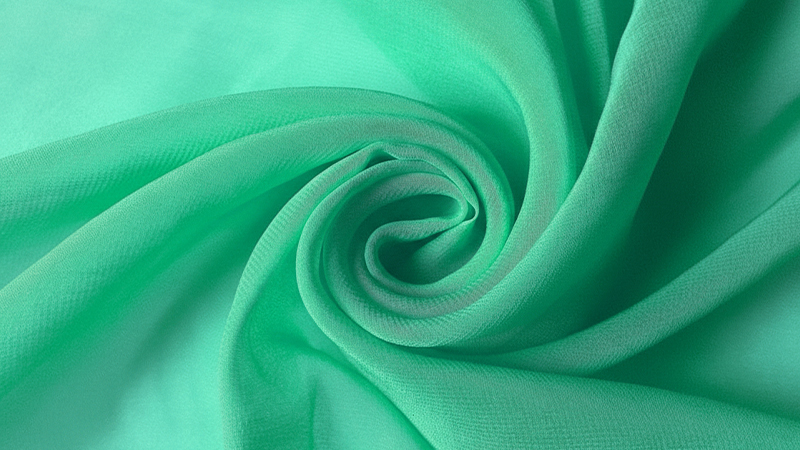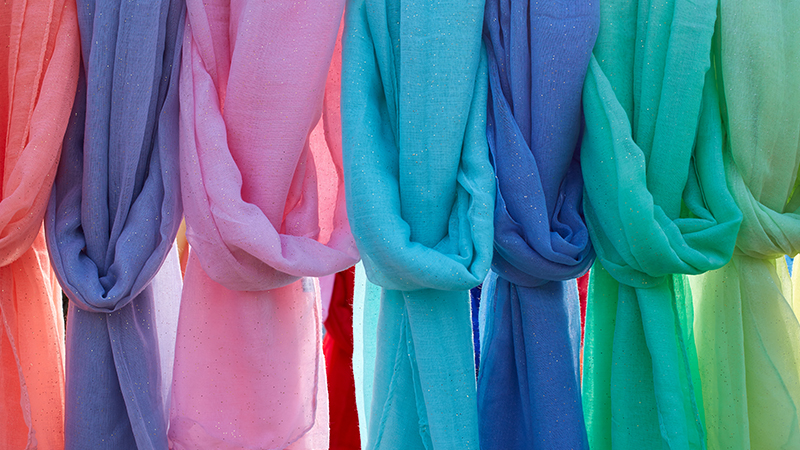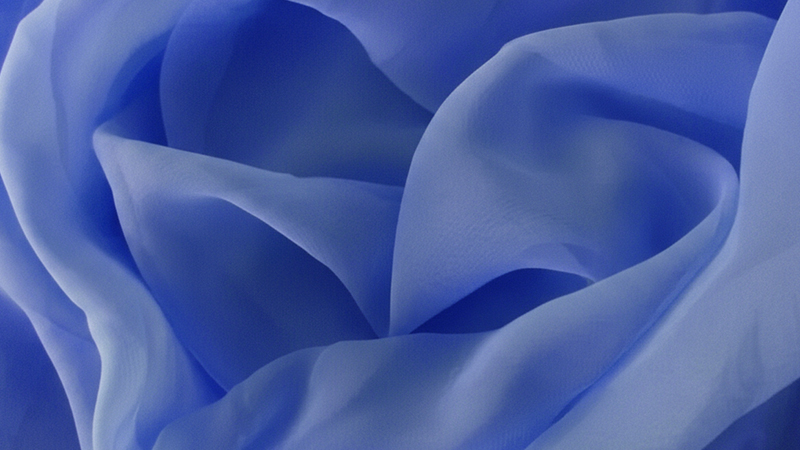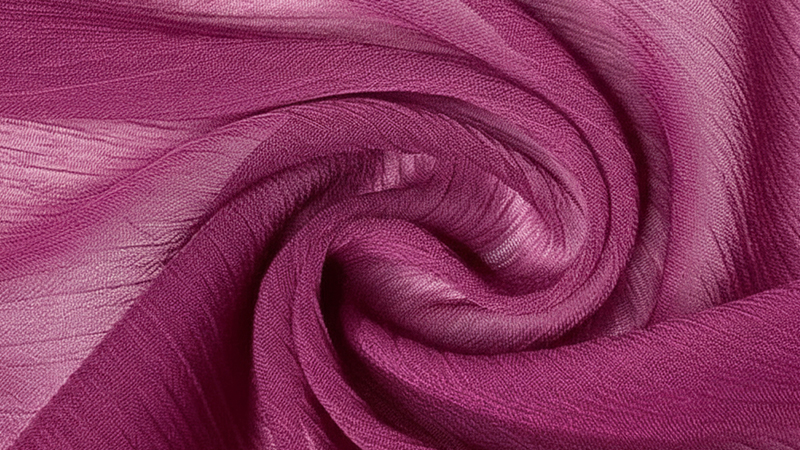
In the expansive world of textiles, few fabrics capture the essence of grace and versatility quite like Georgette. Often considered a sister fabric to crêpe, Georgette is celebrated for its sheer, light, and flowy nature.
While historically crafted from silk, modern innovations have expanded its composition to include various synthetic materials, making it accessible to a wider audience.
Its defining characteristic is a signature crinkle, born from a unique weave of tightly wound s-twist and z-twist threads, which lends itself to a beautifully flattering drape when worn.
Why Georgette Continues to Captivate
Georgette’s allure is multifaceted. Its remarkable ability to drape elegantly makes it a favored choice across diverse fashion segments, from the pinnacle of high-end design to comfortable casual wear.
The fabric’s unique interplay of texture, a slightly rough, crumpled feel contrasting with a sleek, flat, matte sheen, distinguishes it from other silky textiles.
Furthermore, its evolution from an exclusive luxury item to one that embraces more accessible synthetic options underscores its enduring relevance and adaptability in the global textile market.
This blog post will delve into every facet of Georgette, offering a comprehensive guide to its past, present, and future.
The Legacy of Georgette: A Journey Through Time
Few fabrics carry as much history, elegance, and timeless charm as georgette. Known for its lightweight, sheer texture and graceful drape, georgette has been a staple in fashion and textile art for more than a century.
The Birth of an Icon
The invention of Georgette fabric dates back to the early 20th century, credited to French designer Georgette de la Plante.
It is widely believed that Plante sought to create a more robust alternative to the popular, yet fragile, chiffon fabric of her time, which was similar in texture but prone to damage.
This innovation provided designers with a fabric that offered comparable sheerness and elegance but with enhanced durability.
Popularity and Evolution
Georgette experienced initial peaks in popularity in Western culture shortly after its creation and again in the 1930s. While its common usage in the West might have seen fluctuations, it has consistently appeared in significant fashion moments.
For instance, polyester Georgette was notably used in staple pinafore dresses of the 1970s. In contemporary high fashion, Georgette continues to grace runways, exemplified by Chanel’s 2021/22 Métiers D’Art collection, which featured embroidered real silk Georgette.
Understanding Georgette: Properties

Georgette is one of the most admired fabrics in the textile world, valued for its lightweight feel, graceful drape, and timeless elegance.
To truly appreciate this fabric, it’s important to understand its properties and the different types that have evolved over time.
Characteristics and Varieties
To truly appreciate Georgette, it is essential to understand its unique properties and the diverse forms it takes, influenced by material and weave.
Georgette’s distinctive characteristics make it stand out:
- Lightweight, sheer, and breathable.
- Defined by its crinkled or “puckered” texture, a direct result of its unique S- and Z-twisted yarn weave.
- Remarkably more robust than chiffon, allowing it to maintain structure despite being a fine fabric.
- It can be opaque or translucent, yet consistently presents a sleek, flat, matte sheen.
- Exhibits low pilling, ensuring longevity and maintaining its aesthetic appeal.
- Specifically, silk Georgette offers high moisture-wicking ability and medium stretchiness, making it comfortable, especially in warmer climates.
Types of Georgette: Material Matters
The versatility of Georgette extends to its material composition, leading to various types:
Silk Georgette:
This is the original and often implied form when “Georgette fabric” is mentioned without further specification. It embodies the classic elegance and natural properties of silk.
Polyester Georgette (Poly Georgette):
A modern, less expensive, and high-class alternative to silk. It boasts practical benefits such as being machine washable and wrinkle-resistant. This variant has even found its way into high fashion, as seen in Hermès’ Autumn and Winter 21/22 collection.
Stretch Georgette:
Created by incorporating spandex or Lycra, this type offers enhanced stretchiness and comfort. It is frequently chosen for bridal wear due to its smooth, flowy appearance and reduced stiffness compared to pure silk.
Different Weaves, Different Effects
Beyond material, variations in weaving techniques also produce distinct Georgette fabrics:
Double Georgette:
A thicker version that provides more coverage and durability than its regular sheer counterpart.
Satin Georgette:
Features a satin weave that imparts a shiny finish, offering a stark contrast to the standard matte appearance of other Georgette types.
Jacquard Georgette:
This is woven on a jacquard loom, enabling the creation of complex patterns directly into the fabric, rather than through dyeing or stitching.
How Georgette is Made and Used

The unique aesthetic of Georgette is a direct result of its specialized manufacturing process and its subsequent applications across fashion and home décor.
The Weaving Process
The signature crinkled texture of Georgette is achieved through a precise weaving technique involving two distinct types of yarn:
- S-twist yarn: Spun in a counter-clockwise direction.
- Z-twist yarn: Spun in a clockwise direction.
These yarns are tightly wound together in alternating directions, which creates the characteristic “puckered” or crinkled surface that defines Georgette fabric.
This specific weave is crucial, enabling the fabric to be made from fine threads, like silk, while maintaining a structure more robust than other delicate silks.
Georgette in Fashion and Home
Georgette’s versatility lends itself primarily to clothing, though it also finds decorative uses in home design. Its non-exceptional durability typically limits its use to apparel and decorative applications rather than heavy-wear items.
- Dresses: Georgette is an ideal choice for various dresses, from formal wear like ballgowns and bridal wear to more casual summer dresses. Its exceptional drape works perfectly with styles such as empire waists, A-line, ball gowns, and wrap dresses. Its cool breathability also makes it suitable for short summer dresses.
- Blouses: The fabric is excellent for loose-fitting blouses, accommodating various sleeve lengths (three-quarter, long, or short) beautifully.
- Saris: Particularly in Eastern countries like India, Georgette, especially silk Georgette, is highly favored for saris. Its light, airy texture beautifully showcases the layered, bright, and vibrant patterns typical of saris.
- Home Decoration: While not suitable for high-wear items like rugs or heavy cushion covers, Georgette fabric is frequently used for decorative purposes such as window covers, pillows, and table decorations.
Georgette Dilemma: Pros, Cons, and Alternatives

Understanding the advantages, disadvantages, and readily available alternatives is crucial for making an informed choice about Georgette fabric.
Advantages of Georgette
Georgette offers several compelling benefits that contribute to its enduring appeal:
- Comfort and Drape: It is light, flowy, and comfortable, gracefully embracing the body’s curves while maintaining a flattering, loose appearance.
- Breathability and Dye Absorption: Pure silk Georgette is notably breathable, making it ideal for warmer seasons like spring and summer. Silk fabrics are also highly absorbent, which keeps the wearer cool and allows them to take dyes exceptionally well, resulting in bright, vibrant colors.
- Hygienic and Hypoallergenic: Silk naturally repels mold and dust, simplifying storage and making it a hypoallergenic option.
- Relative Strength: While not a strong fabric, silk Georgette is stronger than chiffon, allowing for more intricate embellishments like embroidery and requiring slightly less delicate handling.
Disadvantages and Maintenance Challenges
Despite its beauty, Georgette comes with specific challenges:
- Maintenance Intensity: Georgette, especially silk, can be tricky to maintain. It cannot be dried in direct sunlight, as this may cause color loss, and tumble drying is strictly prohibited. In most cases, dry cleaning is recommended.
- Cost: Silk Georgette, being a luxurious natural fiber, is expensive.
- Difficulty in Sewing: Its sheer and delicate nature makes it challenging to work with, even for experienced sewists.
Alternatives for Every Need
For those seeking Georgette’s aesthetic without its inherent challenges, several alternatives exist:
- Easier-to-Maintain Alternatives:
- Stretch Georgette and Poly Georgette are excellent alternatives to silk Georgette for their improved care properties. Polyester Georgette, for instance, is machine washable and wrinkle-resistant.
- Similar Feel, Easier to Sew:
- Silk Charmeuse: Offers a similar “water-like” drape and feel. While still silk and delicate, its flatter backside can make it slightly easier for sewists to handle than Georgette.
- Light Jersey Cotton: Provides a comparable drapey, flowy feel but is significantly easier and less expensive to sew than Georgette. Being a knit fabric rather than woven, it offers more forgiveness.
- Lycra Blends: These synthetic blends are often slinky like silks, yet flexible and much easier to sew, commonly mixed with materials like polyester, cotton, or wool.
- Similar Look, Less Translucent:
- Silk Crepe de Chine: This fabric offers a similar elegant look but is thicker than Georgette, providing more coverage and being wrinkle-resistant and breathable. However, as it is also silk, it does not offer an easier sewing experience.
Making an Informed Choice: Sourcing, Cost, and Ethics
Understanding the global supply chain, cost structures, and crucial certifications empowers consumers and businesses to make responsible and informed choices when procuring Georgette fabric.
Global Production Hubs
The primary production centers for Georgette vary depending on its material composition:
- Silk Georgette: The vast majority of the world’s raw silk supply originates from China (approximately 78%) and India (producing around 35,000 metric tons per year).
- Polyester Georgette: Major manufacturers are concentrated in China (around 14 million tons annually), India (about 10 million tons annually), and Indonesia. These two nations alone account for a significant portion of the global polyester market, which saw 55 million metric tons produced in 2018.
- Stretch Georgette (Lycra): China is the primary producer of Lycra, the key component of stretch Georgette, with global sales reaching about 1 million tons of Lycra fiber in 2020.
Cost Considerations
The cost of Georgette fabric fluctuates significantly based on its material, design, and embellishments:
- Silk Georgette:
- Solid colors typically range from $20-$40 per yard.
- Patterned fabrics generally cost more, between $30-$60 per yard.
- Embellished versions (e.g., embroidered, sequined) can command prices from $40 per yard up to $140 per yard.
- Polyester Georgette (Poly Georgette):
- Solid colors are considerably less expensive, usually $5-$7 per yard.
- Patterned synthetic fabrics range from $7-$15 per yard.
- Embellished retail polyester Georgette typically costs $13-$30 per yard, with handmade options potentially being higher.
Certifications and Ethical Sourcing
To ensure authenticity, safety, and ethical production, several certifications are vital:
- OEKO-TEX® Certification: This independent system guarantees textiles are free from harmful chemicals such as arsenic, lead, pesticides, and formaldehyde. The OEKO-TEX® Standard 100 specifically ensures that products are free from these substances at all stages of production. Furthermore, the OEKO-TEX® Made in Green certification extends beyond chemical safety to include standards for safe working conditions and environmental responsibility.
- GOTS (Global Organic Textile Standard) Certification: This is the highest award for organic fabrics, verifying that a textile has been sustainably sourced from start to finish. GOTS-certified silks must contain at least 70% organic material (or 90% to be labeled “organic”) and adhere to socially responsible labor practices, including the prohibition of child labor and unsafe conditions, and supporting collective bargaining.
- Peace Silk (Ahimsa Silk): An ethical alternative to conventional silk production, Peace Silk is produced without harming silkworms, allowing them to complete their metamorphosis and emerge from their cocoons naturally. Various types of silk, including Mulberry, Eri, Muga, and Tussar, can be processed as Peace Silk.
Identifying Real Silk Georgette
Given the market for synthetic alternatives, verifying genuine silk is important, especially for uncertified or second-hand purchases:
- Hand Touch Test: Real silk typically feels soft and slightly waxy, offering a much smoother texture than synthetic alternatives, even if Georgette has a slight roughness.
- Ring Test: Authentic silk should glide easily through a jewelry ring without snagging. While thicker silks might be harder, Georgette, being fine, should pass through with ease.
- Burn Test: This is the most definitive test for authenticity (though not practical in stores). A small piece of real silk (a natural fiber) will smell like burnt hair and leave behind ash. Synthetic silks, conversely, will smell like burning plastic or rubber and leave no ash.
- The Silk Mark (India): While endorsed by the Indian government to protect consumers, it is not a legal guarantee and can be faked. Personal testing or relying on other robust certifications is often more reliable.
FAQs
What is the main difference between Georgette and chiffon?
Both are sheer and light, but Georgette is more robust than chiffon and has a distinct crinkled texture from its S- and Z-twisted yarns. Chiffon is typically more delicate and prone to breaking.
Can Georgette fabric be washed at home?
Silk Georgette generally requires dry cleaning and should not be tumble dried or dried in direct sunlight to prevent color loss. However, Polyester Georgette is often machine washable and wrinkle-resistant. Always check the specific care label for your garment.
Is Georgette a breathable fabric?
Yes, Georgette, especially silk Georgette, is considered fairly breathable. This makes it a comfortable choice for warmer climates or layered clothing.
How can I tell if silk Georgette is real?
You can perform a hand touch test (real silk feels soft and waxy), a ring test (real silk glides easily through a ring), or a burn test (real silk smells like burnt hair and leaves ash). Look for OEKO-TEX® or GOTS certifications for guaranteed authenticity and ethical sourcing.
What are common alternatives to Georgette if it’s too difficult to sew?
For a similar flowy feel but easier sewing, consider silk charmeuse, light jersey cotton, or Lycra blends. If you need less translucency, silk crepe de chine offers more coverage but is still silk, so not necessarily easier to sew.
Conclusion
Georgette fabric, with its delicate charm and versatile applications, has carved an undeniable niche in the world of textiles.
From its inception by Georgette de la Plante as a robust alternative to chiffon, through its peaks in Western fashion, to its vibrant adoption in Eastern cultures for elaborate saris, its unique drape, lightness, and inherent elegance have ensured its enduring appeal.
Whether it’s the luxurious feel of silk Georgette in a haute couture gown or the practical versatility of poly Georgette in a casual summer dress, the fabric continues to strike a remarkable balance between sophistication and adaptability.





